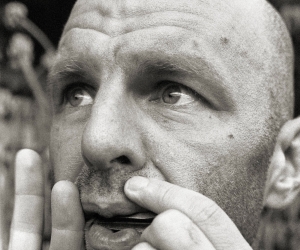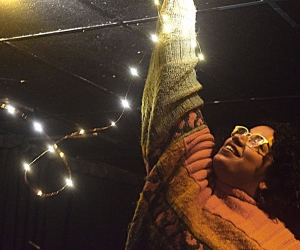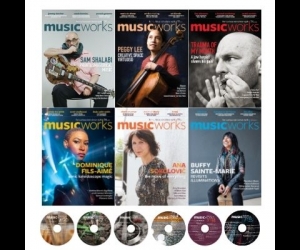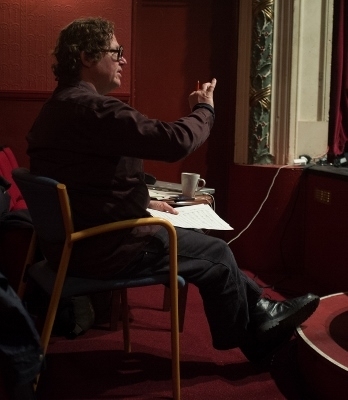
The emergence of Arnold Schoenberg’s twelve-tone technique in the early 1920s not only presented an altogether new conception of pitch in music, it also prompted a dramatic and widespread shift in the fundamental thinking surrounding Western concert music. Its latent quasiscientific implications precipitated a number of new systems of composition. As composers foraged for new material and avenues of investigation throughout the twentieth century, the perceptual dimension of sound came to be scrutinized under this new systematic lens. Psychoacoustics had been vital since the time of Pythagoras, and certainly Helmholtz’s foundational work during the nineteenth century helped keep its concerns in the foreground. The practice, however, of interrogating the creative process with its particular questions was a new development.
Looking at composer Marc Sabat’s meticulous and beautiful scores, reading any of his theoretical writings, or even speaking to him, one senses that here is an artist whose outlook follows this line of thinking almost directly.
Sabat is one of a number of composers working in just intonation (JI). His music posits a sort of ongoing research in which he painstakingly examines the harmonic spectrum in order to identify various constellations of overtones, which then become focal points for a given piece. Over the span of our three-hour conversation in early 2016, Sabat eagerly and cogently enumerated the specifics of his detailed process. While the resultant music bears the fruits of this work, its sound doesn’t readily disclose its internal rigour. That’s no reflection on his craft, though. It’s not to discount manifest precision either. Certainly James Tenney, one of Sabat’s mentors, exemplifies that approach, with many pieces that illustrate particular auditory phenomena with tidy elegance.
Sabat is also invested in exploring this intersection of perception and microtonality, but his music doesn’t reflect the didacticism, or conversely the obscurantism (in the case of weaker composers), that often accompanies such pursuits. He doesn’t trade in perfectly calibrated procedures that unspool at just the right velocity. Instead, his research fuels supple lyrical interplay that transpires within patiently shifting tapestries of music.
Born in Kitchener, Ontario, in 1965, Sabat was attracted to music from a young age. On a family vacation to Montreal in the late 1960s, hourly eruptions of clangour, such as the tolling of the church bells, inspired his wide-eyed astonishment—at least according to his late mother. The first encounter with music Sabat recalls on his own was a performance by violinist Andrij Wasylushko at a Ukrainian cultural event in Kitchener. The impression was so powerful that he immediately demanded violin lessons.
Sabat’s studies in Kitchener ended abruptly when his father, a mathematics professor, secured a post at the University of New Brunswick. The family’s relocation to Fredericton did nothing to curtail young Marc’s enthusiasm for music, and he quickly took up private lessons in theory rudiments and harmony with Robert C. Bayley, a noted pedagogue who happened to live nearby. Violin lessons were maintained as well, but Bayley’s instruction stoked a burgeoning curiosity about composing. Sabat’s parents sought out Janis Kalnins, a Fredericton-based composer of Latvian extraction, to build on the necessary theoretical foundation, while offering a grounding in composition. Lessons covered everything from counterpoint to orchestration, and even the basics of twelve-tone technique. Kalnins also relayed historical context to dissect works by contemporary composers such as Stravinsky and Stockhausen.
Even then, Sabat was prone to self-directed research. His parents had taken to driving him six hours to Halifax every other week for violin lessons with revered teacher Philippe Djokic. On one of these journeys his father purchased him composer Brian Cherney’s book on the eclectic music of fellow Canadian composer Harry Somers. Somers’ journey through different organizational techniques—tonality, serialism, and then into techniques derived from Islamic song and travels in Iran—intrigued Sabat and inspired him to investigate alternative means of working with pitch.
After high school, he enrolled in the University of Toronto with the intention of pursuing parallel degrees in violin performance, composition, and mathematics. Pragmatism trumped ambition though, and violin surfaced as the most viable professional option. His decision to specialize was vindicated when he was accepted at the Juilliard School of Music, where he earned a master’s degree in violin performance. Following Juilliard, Sabat joined the Atlantic String Quartet in 1989, and the attendant relocation to St. John’s, Newfoundland, was crucial in reorienting him creatively. The city’s Sound Symposium, still a touchstone in the Canadian experimental music landscape, played a large role in reinvigorating his creativity; in his ongoing private studies, his discovery of Harry Partch’s Genesis of a Music at the local library was nothing short of revelatory. He recalls it sitting on the shelf amongst the other music books, its pristine spine betraying how little it was read. The silver-tongued critiques inside seemed somehow enhanced because the book’s first page bore Partch’s personal signature. Sabat pored over its theoretical parts, engrossed in the expansive harmonic worlds it described so vividly. During his year in St. John’s, he purchased a Yamaha SY77, a synthesizer notorious for its extensive microtonal engine.
The following year Sabat took up informal studies in electronic music at McGill University with Bruce Pennycook and alcides lanza, a move congruent with his growing interest in this scientific domain. He immersed himself in Montreal’s vibrant experimental music scene, attending concerts that opened complementary channels of exploration. The powerful musical voice and adroit insights of renowned violinist and improviser Malcolm Goldstein soon became instrumental in steering Sabat toward his own improvisatory practice on the violin. While Sabat’s creative work had gained considerable momentum, he continued to nurture his career as an interpreter. Following a move back to Toronto in 1992, this aspect coalesced with his more personal forays into intonation. Shannon Peet solicited his participation in a James Tenney retrospective as part of the final instalment of the New Music Across America festival. Sabat thereby not only gained intimate knowledge of Tenney’s work and its way of addressing tuning through notation, but he also got better acquainted with Tenney personally.
The following summer, Sabat wrote Three Chorales for Harry Partch, the earliest work in his current catalogue. Scored for a duo of retuned violin and viola, the piece neatly encapsulates salient features of Sabat’s early career: improvisation, intonation, and a growing penchant for minimalism. Its compact visual articulation betrays the influence of Tenney’s taut notational approach. The work’s mere three staves present a simple unfolding of a utonal sonority (pitches derived from the subharmonic series). Its surface simplicity is muddied by the score’s performance notes, which insist, “timbre is free and ought to be varied using all possibilities ranging from pure pitch to noise, using the timbral idiosyncrasies of the loosely detuned strings as well as the tonal purity of the normally tuned strings . . . The model is of sound ‘in slow motion,’ as though string playing were being examined through a microscope in time.” The rarefied presentation of the piece, both in score and in the utter patience with which it unfolds, exists only to frame the experience and allow listeners to sense a natural gravity toward the various details that arise over its course.
The performance notes also cite Steve Reich’s 1967 spartan conceptual score Slow-Motion Sound (“Very gradually slow down a recorded sound to many times its original length without changing its pitch or timbre at all”). Reich wrote this piece after his foundational tape pieces, It's Gonna Rain and Come Out, and it foreshadows many later technological advances—especially granular synthesis—that would facilitate realizing such a score. Even in 1993, when Sabat composed Three Chorales, such electronic techniques were still sufficiently inaccessible that Reich’s writing retained a sensuously imaginary resonance—an undoubted source of inspiration.
Another source of inspiration is clearly stated in the title, and Partch’s raw and rough-hewn, radically unconservative sonic qualities, whose feral, folk-inspired colourations are implicit in the performance notes just quoted. Sabat’s prior encounter with Partch’s theoretical writings in Genesis of a Music hadn’t adequately prepared him for the rustic onslaught of the actual music. When he finally heard a work by Partch—O Frabjous Day, a suitably wild reading of Lewis Carroll’s Jabberwocky—it struck his ears with eruptive force. His initial impression remains vivid: a pronounced sense of the discrepancy between how he had expected the music to sound and its realization. The strange mismatch stimulated many questions surrounding the potential of tuning systems to interact with other musical parameters, and thus unlocked entire worlds in Sabat’s mind’s ear.
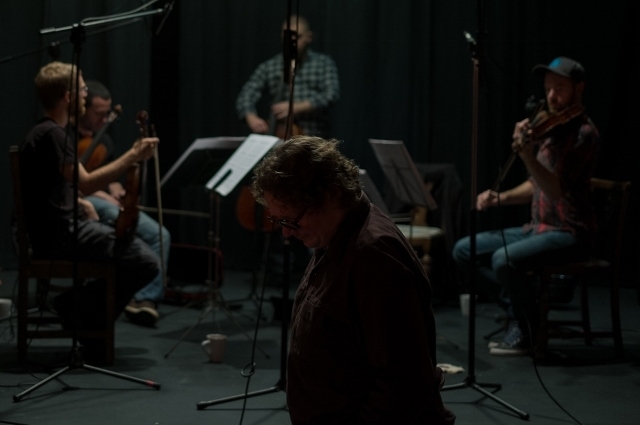
“The repertoire that I was playing was a kind of a crash education,” Sabat notes, connecting his profile as a chamber player to his compositional output. Throughout the 1990s, he was also active in Arraymusic, the Modern Quartet, and Critical Band, a microtonal ensemble he cofounded in 1993. “In a way I am self-taught, even though I studied composition off and on since I was a child. Playing with Arraymusic was a kind of advanced studies for developing my composing.” Sabat’s ad hoc curriculum included the work of a number of Canadian and international composers: Maria De Alvear, Claude Vivier, Martin Arnold, Elliott Carter, and Christian Wolff; and in certain cases these “teachers” were present working with the ensemble.
His tenure with Arraymusic also furnished an enduring collaboration with pianist and fellow composer Stephen Clarke. The two initially met in 1993 at Array’s Young Composers’ Workshop where Clarke was one of the residents. A few years later, the two began working as an interpretive duo, bringing steadfast commitment and intense scrutiny to a large body of work. They produced a number of acclaimed CDs, including career-spanning recordings of Morton Feldman and Wolff for Mode Records, as well as appearing on discs by Tenney, Barbara Monk Feldman, Linda Catlin Smith, and Allison Cameron.
“Marc asked me to write a duo, Thinking, for him and Stephen Clarke,” recalls De Alvear of her initial contact with Sabat. “When they played it to me I was so incredibly touched by it that I thought—and it sounds weird—‘Wow, these people cannot only be interpreters. They must have something beyond that.’ That’s when I knew that Marc Sabat was a composer too.”
In April 1997, Sabat was selected to participate in a yearlong composer residency at Stuttgart’s Akademie Schloss Solitude. Accepting the offer meant halting all performance initiatives, save for his duo with Clarke, but the sacrifice proved fruitful, effectively launching Sabat’s career as a composer. The residency also gave him a taste of the contemporary European artistic climate, which he felt to be more in line with his inclinations. As this affinity began to establish itself more clearly, events conspired to cement Sabat’s decision to stay in Europe, among them the deaths of both of his parents within the span of the year. Fortunately, the Solitude program afforded some leeway for participants to extend their stay, and Sabat seized this opportunity to plan a move, ultimately settling in Berlin in 1999.
Taking up residence in Berlin seemed to quell Sabat’s wanderlust, as his disparate creative streams were given a chance to coalesce. A crucial piece of this newfound coherence began percolating in 2000, when Sabat, alongside fellow microtonal composer Wolfgang von Schweinitz, set about devising a standardized microtonal notation. Formulating the Extended Helmholtz-Ellis Just Intonation Pitch Notation remains somewhat of a work-in-progress, even though its essential features had been defined by 2005. Building on the familiar five-line staff, Sabat and von Schweinitz’s system provides a lexicon of sharp-and-flat-derived symbols that articulate a remarkable degree of shading between each of the standard twelve pitches. According to Sabat’s recent theoretical text, Three Tables for Bob, the Helmholtz-Ellis JI Pitch Notation “allows for notation of the harmonic series from any fundamental as far as the sixty-fourth partial and beyond. In my experience,” he notes, “some intervals up to at least the twenty-third partial may be directly tuned in an appropriately composed register, timbre, and musical context . . . In defining a generally useful subset or region of harmonic space, I would like to provide for a precise notation of intervals which may be tuned directly by ear in a musical context.”
The system is intent on maximizing legibility and plasticity, offering many options to the composer, while conveying the information to the performer in a manner that is familiar to performers and seamlessly integrated into usual forms of music reading.
In contrast to his immaculate scores, the tidiness of which borders on translucency, his underlying gestation process is considerably more arcane—maybe even a bit messy. “I have some kind of ridiculous system. It’s like Homeland,” he chuckles, likening his sketching phase to the behaviour of the TV show’s obsessive lead. “I have the entire wall covered with a thousand pictures and arrows and everything. No one else can understand it but somehow I have it in my mind.” Not unlike the aforementioned Partch homage, his current process often begins with a fairly small unit of musical information—some chords, a cantus firmus, even a gestural relationship. For him, one such unit implies an entire harmonic world that can be exploded via the overtones and subtones of each pitch.
In certain instances, e.g., Artificial Music For Machines (2002), that material can even consist of a preexisting element, in this case, Schoenberg’s Präludium from his Op. 25 suite—one of the very first twelve-tone works. It’s all about discovering the right threads to pull to allow the fabric of the idea to unravel, revealing the material’s full potential. Once it’s all laid out for him, the key, Sabat says, is finding “some kind of scheme that gives enough of a neutral framework within which I can then start to work poetically. I find that the constraint is really helpful.”
Artificial Music, a piece for MIDI-rigged acoustic piano and electronics, systematically takes each of the harmonies from Schoenberg’s piece and draws them out, through durational chance procedures, into flickering spasms of colour that offer the listener more time to reckon with their harmonic content. As the pianist plays, the MIDI triggers sine tones that annotate the equal-tempered notes of the piano with just-intoned commentary, further dislodging the ear from major-minor tonality.
Where Artificial Music operates in a more severe and jagged auditory sphere (indicated by its title) the sumptuous thirty-six-minute chamber concerto for piano Lying in the grass, river and clouds (2012) offers a gentle radiant quality. Yet, in spite of its limpid, quasipastoral surface, much of it was also engineered through generative formulae—here, an adaptation of Tenney’s Crystal Growth algorithm, which organically grows pitch statistics. Using this structure, Sabat mapped a coherent series of pitches of all those available on the piano keyboard. He excavated overtones and subtones from each successive piano note, constructing a sort of harmonic perimeter to accompany the piano soloist. This frame is described by a cast of numerous instruments, as well as sine tones, tracing long strands of quietly emergent colour. As always with Sabat’s work, the strong, distinctive flavours that arrive on the palate of the listener conceal the composer’s scrupulosity.
Delving into his 2011 string quartet Euler Lattice Spirals Scenery also reveals several intensive JI processes at play. The section of the work entitled “Harmonium for Ben Johnston,” Sabat writes [in Three Tables for Bob] “maps a complete journey through the central region of fifty-three pitches combined with their enharmonic periphery: forty-six additional pitches completing just major and minor triads.” Sabat has, in his own words, “composed a pathway through this space of ninety-nine pitches by linking them in a chain of common-tone triadic modulations with one very small enharmonic transition of 4.2 cents.” This same trajectory forms the basis of a forthcoming commission for the twenty-two-piece Berlin Ensemblekollektiv, but, in this case the chain of micromodulations is juxtaposed against more transparent pitch-relationships, creating a sense of auditory perspective.
In addition to the chamber-orchestra work, Sabat, prolific as ever, has several projects on the go. He’s in the course of adapting a recent tanpura duet, Light Ground, into an orchestral piece for the 2016 Tectonics Festival in Glasgow, where it will be presented by the BBC Orchestra. It’s also being rendered as an installation with Canadian artist Mareike Lee. New York’s Ekmeles Vocal Ensemble will also be presenting an a capella work based on a literal translation of Ovid’s Metamorphosis by poet Uljana Wolf. He also has several new recordings in various stages of preparation, including a disc for the English label Another Timbre, and his second release for Maria De Alvear’s World Edition imprint. A theoretical book using his own compositions (and accompanying texts) as the primary material is also in the works.
“With all of the music of Marc’s that I’ve played, there is a consistency of presentation,” recounts Stephen Clarke. “It’s a kind of forthrightness, a clarity of intention I think he admired with[in] James Tenney. With a work like To Damascus, there is that combination of precision and flexibility that I find very appealing. The flexibility is at the performer’s discretion, making it music to be interpreted rather than merely executed.”
Working in such a specific pitch-language inherently makes particular demands on performers, but Sabat otherwise diligently avoids burdening musicians, carefully distributing tasks based on an instrument’s natural harmonic properties. Having the musicians grasp and experience the overall field of pitch and the relationships within it is a huge priority, as the performance itself needs to transmit to the audience a sense of listening.
UK sound recordist Simon Reynell—the curator of Another Timbre, a label celebrated for its introverted sonics—likens Sabat’s work with musicians to Jorge Luis Borges’ Funes The Memorious, about an individual whose impressions are so strong that he remembers everything. “The image I have,” says Reynell, “is very powerful—of him sitting in a little stool in the room while they were rehearsing. Eyes shut—screwed shut. He’s almost in agony. His hearing is so precise that it’s almost painful. The Borges story ends with the central character having to live in a darkened room and not expose himself to any stimulus because it’s too much for his brain to cope with. I sort of get a little bit of that feeling from Marc—his hearing and passion are too much for the world, in a way.”
Yet, Reynell adds, “Some earlier just-intonation composers’ work all feels very systematic, almost like they’re working through a process, but aren’t concerned with the emotional aspects of music. Many of Marc’s pieces that I’ve heard . . . I think you can enjoy them without knowing anything about just intonation. I simply enjoy them as a sensual experience.”
“If you don’t have the incredible, accurate feeling of using your instrument then you never will reach the level that he wants when he’s writing music,” affirms Maria De Alvear. Yet, she notes that “his structures help to create sensitivity,” gently conveying the same intensity of aural attention to performers and, by extension, listeners. For her, the ramifications are powerful: “Music goes beyond music,” she says. “It begins with philosophical ideas, political ideas, emotional ideas, and physical ideas, because our body works when we listen to music. Our minds are very plastic, and Marc is creating connections that were not there before. Independently of whether people ‘get it’ or not, he is doing it and it has an effect on us.”
Indeed, according to Sabat, “One can thematize art quite a lot, but in the end, music is really about the things that we experience in listening to sound and through sound. Sound is not hampered by the dimensionality of the world. It’s so multidimensional in our experience of it and in reality, the complexity of the vibration and so on. My hope is that the music can somehow embody the thing itself, the experience of music, in the best sense. I would love it if the sound of my music carries with it a sense of clear thinking.”
“Cage had that beautiful statement about how the experience of sound is always emotional.” states Sabat, responding to my probing about the question of affect in his work. “I think that’s closer to what I would find useful. You want to stay close to that kind of direct emotional experience of sound—childlike joy of the sound itself and at the same time, any one of our individual emotions is not all that important.”
Thus, for all his work’s ostensible ratiocentricism, a rich, idiosyncratic musicality prevails. Yet, to pit the scientific and musical elements against each other misses the point. The seemingly insoluble tension between the music’s stark underlying logic and its aspirations toward the ineffable is what makes it so wondrously beguiling.
“I always think that one of the best compliments I got from Jim [Tenney] was when I played him a piece and he said, ‘You know—it’s beautiful, but I don’t know what the fuck you’re doing.’ He was genuinely perplexed in a really positive way. He couldn’t parse the exact logic of it, but he could tell that there was something kind of logical holding it together and that was, in a way, fascinating to him.”
Homepage slider photo (left to right): Catherine Lamb, Koen Nutters, Marc Sabat, and Andrew Lafkas. World premiere performance fo Light Ground (2016) by Mareike Lee (drawing performance, video) and Sabat in Berlin in April 2016. Photo by: Frank Sperling. Top and middle photos: Marc Sabat during recording session in May 2016 with New York's JACK quartet in Sheffield, UK, for the label Another Timbre. Photo by: David Reid.
